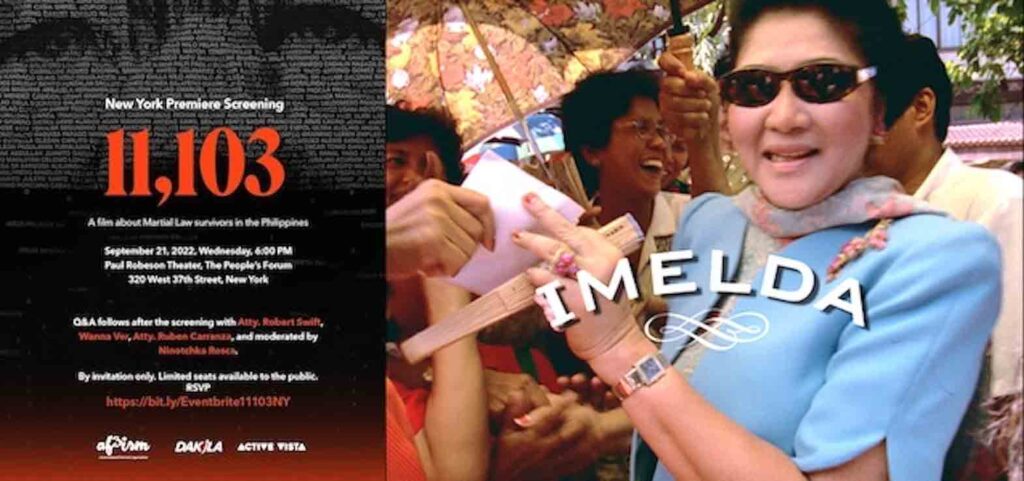
Ramona Diaz’s Imelda (2003), a revelatory and often hilarious portrait of Imelda Marcos, and Jeanette Ifurung and Miguel Alcazaren’s 11,103, are reminders of a past that still intrudes into the present. HANDOUTS
NEW YORK—When People Power forced Ferdinand and Imelda Marcos to flee for the safety of Hawai’i and the warm embrace of Uncle Sam in 1986, we all breathed a sigh of relief. And vowed, collectively, Never Again. And for a while that held true. It seemed that democracy was in relatively good hands, Cory Aquino, widow of the martyred opposition senator Benigno “Ninoy” Aquino and true winner of the 1985 presidential elections, taking over as president in the immediate aftermath of People Power. The Presidential Commission on Good Government was set up, to go after wealth that had been stolen by the Marcoses and their cronies.
Now, with the 51st anniversary this September 21st of the late dictator Ferdinand Marcos’ declaration of martial law, the nation finds itself with the late dictator’s namesake son, more popularly known as BongBong, as president. Never Again has unfortunately mutated into Here We Go Again. The current president has declared the era of martial law “a golden age.”
Clearly, the political and social developments since 1986 have drastically tempered if not obscured our high hopes for a radically transformed progressive society. Plus ça change, plus c’est la même chose. The more things change, the more they remain the same.
To commemorate the anniversary, New York University’s Sulo: Philippine Studies Initiative (of which I am a member) organized and presented a program that included the screening of two films, Ramona Diaz’s Imelda (2003), a revelatory and often hilarious portrait of Imelda Marcos, and Jeanette Ifurung and Miguel Alcazaren 11,103.
Just released last year, the 11,103 documentary compiles the stories of mostly unheralded victims of the Marcos regime, the filmmakers pointing out that most of the stories the public has seen and heard previously had been those of well-known figures who had opposed in varying degrees the martial law regime. As is by now well-documented, due to state-sponsored violence, thousands of Filipinos were incarcerated, tortured, raped and killed during the martial law regime of the dictator, Ferdinand Marcos. Whole communities were displaced, if not massacred, by the government’s militarized response to two insurgencies: that of the Maoist-leaning New People’s Army and Muslim separatist armed groups, the Moro National Liberation Front (MNLF) and the Moro Islamic Liberation Front (MILF).
Almost two decades after People Power, in 2013, the Philippine Congress finally passed a landmark law, the Human Rights Victims Reparation and Recognition Act, which officially recognized these abuses of human rights and mandated compensation for the victims, funded by the illegally-acquired wealth of approximately $10 billion of Ferdinand and Imelda Marcos hidden in their Swiss bank accounts. Eleven thousand one hundred three victims were given compensation as a result of the law, hence the film’s title.
The film is a powerful memorial to the depth and breadth of the injustices inflicted on the body politic by a corrupt and crony-infested regime. And a testament that gives voice to the often voiceless. But it is also a needed reminder that Philippine democracy is still on shaky grounds. It includes footage of BongBong Marcos interviewing former defense minister Juan Ponce Enrile, one of the architects of martial law, wherein Enrile defiantly claims that no one was arrested or detained illegally during martial law. Technically, that is true, for individuals were arrested and detained under martial law, and by definition that means the suspension of the writ of habeas corpus.
The film also includes BBM campaigning for the presidency and attracting huge crowds. And he wins! How did such a turn-around come about? Ifurung and Alcazaren don’t address this head-scratcher of a question, as perhaps this would have complicated and even deflected from their intent: make the film all about the victims. Fair enough.
Still, the film would have certainly gained in depth and complexity by even a brief examination of the social, political, and economic conditions of Philippine society at that time, including references to the twin insurgencies mentioned earlier. Such contextual framing would have given us a better understanding both of the precariousness and preciousness of Philippine democracy then (not that it enjoys robust health at the moment) and of the victims’ plight as sacrificial lambs to the new repressive order.
For one day only, this past September 21, the film was screened in selected venues across the archipelago. Whether it will get a longer and wider distribution remains to be seen, though the odds of that happening are slim, given who’s in power. Should a screening be slated at a theater near you, I urge you to see it.
Copyright L.H. Francia 2023
,

